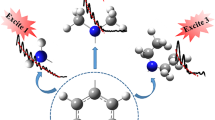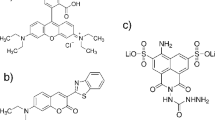Abstract
Förster resonance energy transfer (FRET) is examined in a single donor (D)–acceptor (A) pair whose molecules have both singlet and triplet states. Two cases are considered: (i) the excitation of the D–А pair occurs with the participation of a singlet band of the donor, and (ii) the excitation also involves the participation of an additional triplet–triplet absorption. The triplet state of the donor is shown to have no effect on the expression for the FRET efficiency, but it generates off intervals in the fluorescence track of both the donor and the acceptor. The triplet state of the acceptor strongly affects the expression for the FRET efficiency, making the complete energy transfer impossible and generating off intervals in the acceptor fluorescence track. It is shown that, if the light can excite not only the singlet transition in the donor, but also the triplet–triplet absorption band, then a weak luminescence appears in off intervals, which is orders of magnitude weaker than that in on intervals.






Similar content being viewed by others
REFERENCES
Th. Förster, Delocalized Excitation and Excitation Transfer. Modern Quantum Chemistry, Part III: Action of Light and Organic Crystals (Academic, London, New York, 1965), p. 93.
V. L. Ermolaev, E. N. Bodunov, E. B. Sveshnikova, and T. A. Shakhverdov, Radiationless Electronic Excitation Energy Transfer (Nauka, Leningrad, 1977) [in Russian].
W. E. Moerner and L. Kador, Phys. Rev. Lett. 62, 2535 (1989).
M. Orrit and J. Bernard, Phys. Rev. Lett. 65, 2716 (1990).
A. V. Naumov, Phys. Usp. 56, 605 (2013).
S. Weiss, Science (Washington, DC, U. S.) 283, 1676 (1999).
I. S. Osad’ko, Phys. Usp. 49, 19 (2006).
I. S. Osad’ko, A. V. Naumov, I. Yu. Eremchev, Yu. G. Vainer, and L. Kador, Phys. Rev. A 86, 053802 (2012).
T. Ha, A. Y. Ting, J. Liang, A. A. Deniz, D. S. Chemla, P. G. Schulz, and S. Weiss, Chem. Phys. 247, 107 (1999).
C. R. Sabanayagam, J. S. Eid, and A. Meller, J. Chem. Phys. 122, 061103 (2005).
C. R. Sabanayagam, J. S. Eid, and A. Meller, J. Chem. Phys. 123, 224708 (2005).
I. V. Gopich and A. Szabo, J. Phys. Chem. B 114, 15221 (2010).
H. S. Chung, I. V. Gopich, K. McHale, T. Cellmer, J. M. Louis, and W. A. Eaton, J. Phys. Chem. A 115, 3642 (2011).
I. S. Osad’ko, Bull. Russ. Acad. Sci.: Phys. 81, 543 (2017).
I. Yu. Eremchev, N. A. Lozing, A. A. Baev, A. O. Tarasevich, M. G. Gladush, A. A. Rozhentsov, and A. V. Naumov, JETP Lett. 108, 30 (2018).
K. R. Karimullin and A. V. Naumov, J. Lumin. 152, 15 (2014).
B. T. Bajar, E. S. Wang, S. Zhang, M. Z. Lin, and J. Chu, Sensors 16, 1488 (2016).
B. A. Camley, F. L. H. Brown, and E. A. Lipman, J. Chem. Phys. 131, 10459 (2009).
I. S. Osad’ko and A. L. Shchukina, Phys. Rev. E 85, 061907 (2012).
I. S. Osad’ko, J. Phys. Chem. C 122, 24394 (2018).
Funding
The work was performed under the theme “Spectroscopy of Solids, Surfaces, and Nanostructures” of a state order for the Institute for Spectroscopy of the Russian Academy of Sciences.
Author information
Authors and Affiliations
Corresponding author
Ethics declarations
The authors declare that they have no conflict of interest.
Additional information
Translated by V. Rogovoi
Rights and permissions
About this article
Cite this article
Osad’ko, I.S. Electronic Energy Transfer in a Single Donor–Acceptor Pair with Triplet–Triplet Absorption. Opt. Spectrosc. 127, 1–6 (2019). https://doi.org/10.1134/S0030400X1907021X
Received:
Revised:
Accepted:
Published:
Issue Date:
DOI: https://doi.org/10.1134/S0030400X1907021X




